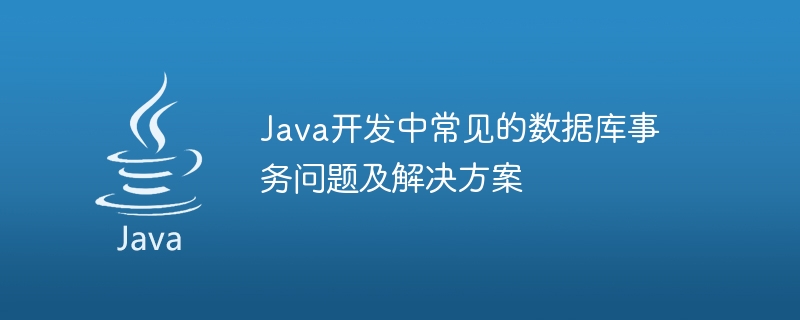

Common database transaction problems and solutions in Java development
Introduction:
In Java development, database transactions are a very common and important concept. Transactions can ensure the consistency and isolation of database operations and ensure data integrity. However, in the actual development process, we will encounter many problems related to database transactions. This article will introduce some common database transaction problems and provide corresponding solutions and sample code.
1. Concurrency issues caused by transaction isolation level
Transaction isolation level is an important mechanism for database to control concurrent access. Different isolation levels correspond to different concurrency issues. The most common concurrency problems include dirty reads, non-repeatable reads, and phantom reads.
Sample code:
Connection connection = dataSource.getConnection(); connection.setTransactionIsolation(Connection.TRANSACTION_READ_COMMITTED);
Sample code:
Connection connection = dataSource.getConnection(); connection.setTransactionIsolation(Connection.TRANSACTION_REPEATABLE_READ);
Sample code:
Connection connection = dataSource.getConnection(); connection.setTransactionIsolation(Connection.TRANSACTION_SERIALIZABLE);
2. Transaction management issues
Sample code:
@Transactional
public void insertData(Data data) {
//插入数据操作
dataDao.insert(data);
if (conditionNotMet) {
throw new RuntimeException("条件不满足,回滚事务");
}
}Sample code:
@Transactional
public void updateData() {
//更新数据库1数据
dataDao.update(db1Data);
//更新数据库2数据
dataDao.update(db2Data);
}3. Deadlock problem and solution
Sample code:
Connection connection = dataSource.getConnection();
Statement statement = connection.createStatement();
boolean success = statement.tryLock(timeOut);
if (!success) {
throw new RuntimeException("获取锁超时,终止事务");
}Sample code:
Connection connection = dataSource.getConnection();
connection.setAutoCommit(false);
PreparedStatement statement = connection.prepareStatement("UPDATE table SET column = ? WHERE id = ?");
statement.setString(1, value);
statement.setLong(2, id);
statement.executeUpdate();
connection.commit();Conclusion:
Database transactions are a very important concept in Java development, which can ensure the consistency and isolation of data. However, during the development process, you will encounter some problems related to database transactions, such as concurrency problems, transaction management problems, and deadlock problems. By properly setting isolation levels, using transaction management annotations, using distributed transaction managers, and properly designing transaction processes, we can solve these problems and ensure the stability and reliability of the system.
References:
1. "Detailed Explanation of High Concurrency Programming in Java: Multi-Threading and Architecture Design"
2. "Spring in Practice (4th Edition)"
The above is the detailed content of Common database transaction problems and solutions in Java development. For more information, please follow other related articles on the PHP Chinese website!




